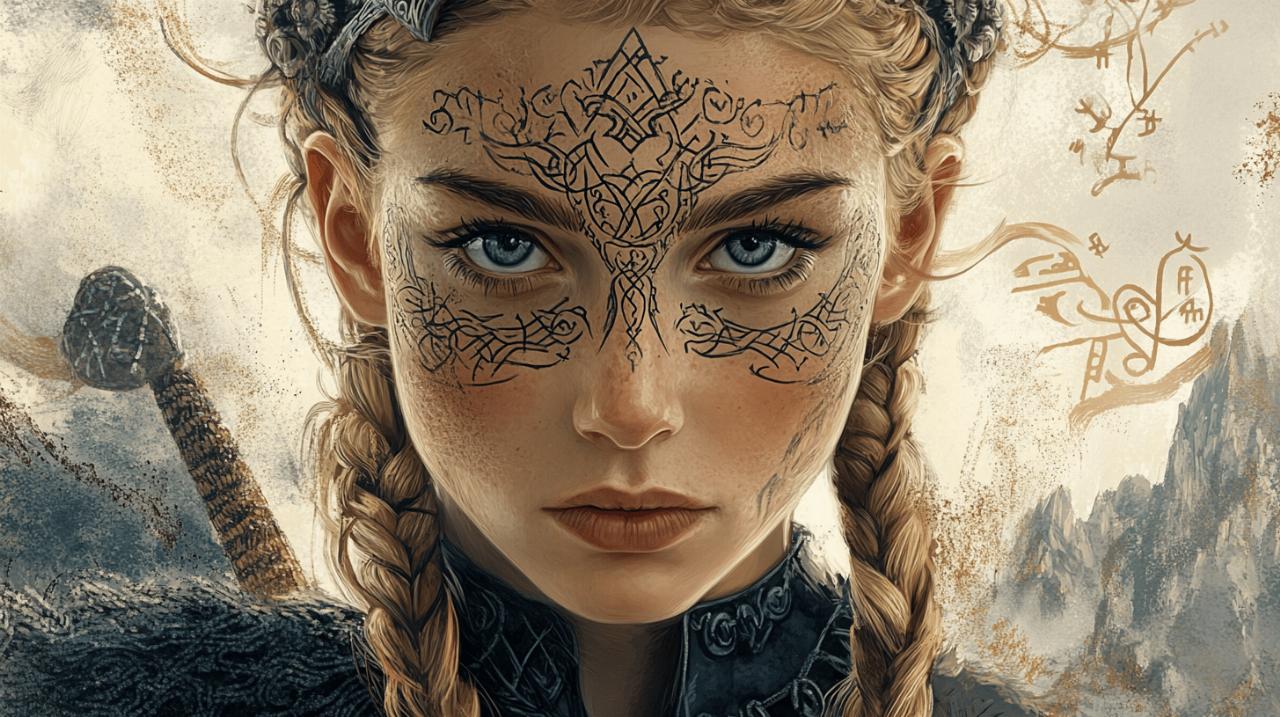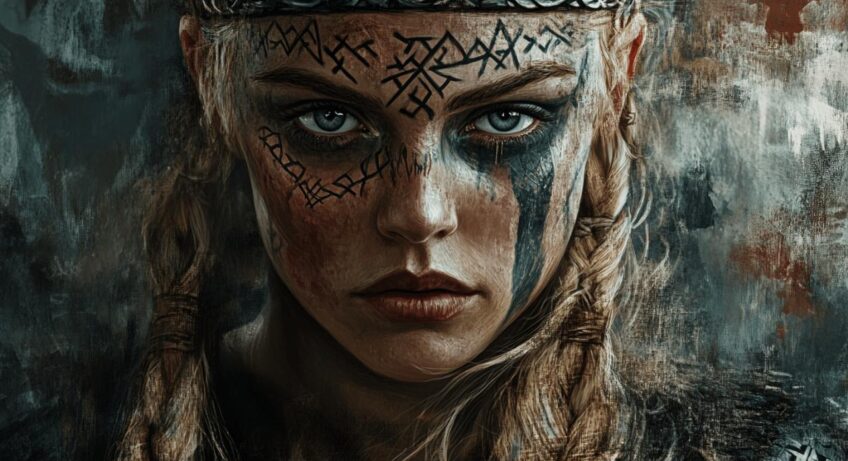During the era spanning from the late eighth to the mid-eleventh century, women of the North approached their appearance with a remarkable blend of practicality and artistry. Contrary to popular images of a rough and unkempt society, the reality was that people from this period placed significant importance on how they presented themselves, using clothing, ornamentation, and carefully arranged hair to communicate their identity, social standing, and cultural values. The choices made by these women reflected not only their daily needs but also their desire to express individuality and maintain connections to their heritage.
Viking Women's Fashion: A Blend of Practicality and Self-Expression
Clothing Fabrics and Their Role in Daily Life
The garments worn by women were predominantly crafted from linen and wool, materials that were well-suited to the often harsh and unpredictable climate of the Scandinavian regions. Linen offered a lightweight and breathable quality, making it ideal for undergarments or warmer seasons, whilst wool provided essential warmth and durability throughout the colder months. These fabrics were not merely functional but also versatile, allowing women to adapt their attire to the demands of their environment and daily activities. The production of textiles was a laborious process, often undertaken within the household, which imbued each piece of clothing with both economic and personal significance. Women who worked at looms and spindles contributed to the family's wealth and status, and the quality of the cloth they produced could serve as a reflection of their skill and resourcefulness.
The selection of fabric was also influenced by availability and trade networks that stretched across vast distances. As communities engaged with neighbouring cultures and distant lands, they gained access to materials and dyes that enriched the variety of textiles available. This cultural exchange meant that clothing was not static or uniform but evolved with influences from other regions, resulting in a dynamic and diverse wardrobe that combined local traditions with imported innovations. The everyday attire was designed to allow freedom of movement, which was essential for women who were actively involved in farming, crafting, and managing household affairs. The cut and construction of garments took into account the need for practicality without sacrificing the opportunity to incorporate elements of beauty and decoration.
Bright Colours and Decorative Patterns as Social Indicators
Far from being drab or monotonous, the clothing of the period was often vibrant and richly adorned with patterns and embellishments. Natural dyes derived from plants, minerals, and insects were used to create a spectrum of colours that ranged from deep reds and rich blues to sunny yellows and earthy greens. The ability to produce or acquire such vivid hues was a sign of wealth and access to resources, as certain dyes required considerable effort or expense to obtain. Women of higher social standing might wear garments dyed in colours that were rare or difficult to produce, thereby signalling their elevated position within the community. The use of bright colours and intricate patterns was not merely decorative but served as a visual language that communicated information about the wearer's identity, family connections, and social role.
Decorative elements were often incorporated into clothing through techniques such as embroidery, appliqué, and the addition of metal threads or beads. These embellishments could be geometric in nature, featuring repeating motifs that held cultural significance, or they might depict stylised representations of animals and mythological symbols. The labour-intensive nature of such decoration meant that heavily adorned garments were treasured possessions, passed down through generations or worn on special occasions to display the family's prosperity. The interplay of colour and pattern in clothing allowed women to express their personal taste and creativity within the boundaries of social norms, making fashion a dynamic aspect of daily life that was both individual and communal. The aesthetic choices made in clothing were part of a broader cultural framework in which appearance played a crucial role in social interaction and the construction of identity.
Adornments and Beauty Rituals: Jewellery and Makeup in Viking Culture
Jewellery as a Marker of Status and Identity
The wearing of jewellery was an integral part of how women presented themselves and conveyed their place within society. Items such as rings, necklaces, and bracelets were crafted from a variety of materials, including precious metals like silver and gold, as well as semi-precious stones and glass beads. The quality and quantity of jewellery a woman possessed were direct indicators of her family's wealth and her own social standing. Brooches, often paired and used to fasten clothing at the shoulders, were particularly significant pieces that combined functionality with decorative artistry. These fastenings were sometimes intricately designed, featuring elaborate filigree work or inset stones, and they served as focal points of an outfit that drew the eye and communicated status at a glance.
Beyond their aesthetic appeal, these adornments carried symbolic meanings and could denote affiliations with particular clans or regions. The styles and motifs found in jewellery often reflected local traditions and artistic conventions, but they were also influenced by contact with other cultures through trade and exploration. Women might wear items that had been gifted to them as part of marriage agreements or inherited from ancestors, making jewellery repositories of personal and familial history. The act of wearing such pieces was a way of maintaining continuity with the past whilst participating in the present social fabric. The variety and richness of jewellery found in archaeological contexts underscore the importance of personal adornment in expressing identity, aspirations, and connections to a wider cultural heritage.
Natural makeup and beauty practices among viking women
Though the details of cosmetic practices from this era remain somewhat elusive, evidence suggests that women did engage in the application of makeup to enhance their appearance. Natural pigments were likely used to create effects such as highlighting the eyes or adding colour to the lips and cheeks. The use of such cosmetics would have been rooted in the availability of local resources, with materials like ochre, charcoal, and plant-based dyes providing the necessary hues. The application of makeup was probably a subtle art, aimed at accentuating natural features rather than creating dramatic transformations, aligning with broader aesthetic values that celebrated both health and vitality.
Personal grooming extended beyond makeup to encompass a range of hygiene practices that were considered essential for respectability and social acceptance. Historical accounts, including observations from outside the culture, indicate that bathing was a regular activity, with individuals often using saunas or natural water sources to cleanse themselves. Washing the hands and face daily was a customary practice, and this attention to cleanliness was seen as a marker of civilised behaviour. Combs, crafted from materials such as whale bone or deer antler, were ubiquitous possessions used not only to style hair but also to remove dirt and parasites. These grooming tools were so valued that they were frequently placed in burials, attesting to their importance in daily life. Additionally, small implements that may have served as ear spoons have been found in women's graves, suggesting that meticulous personal care extended to areas that might seem minor but were nonetheless significant in the pursuit of a well-kept appearance.
Hairstyles and Symbolism: Braids as a Defining Feature of Viking Femininity
The Practical and Aesthetic Appeal of Braided Hairstyles
 Hair was a central aspect of appearance, and its styling was imbued with both practical considerations and symbolic meaning. For women, long hair was generally the norm, and it was often arranged in ways that kept it manageable whilst also showcasing its beauty. Braided hairstyles were particularly popular, serving the dual purpose of preventing tangles and creating an attractive, orderly appearance. The act of braiding could be simple or elaborate, with variations that ranged from single plaits to complex arrangements incorporating multiple strands. Such styles were well-suited to the demands of daily life, keeping hair secure during physical labour or outdoor activities whilst still allowing for personal expression through the intricacy of the braiding technique.
Hair was a central aspect of appearance, and its styling was imbued with both practical considerations and symbolic meaning. For women, long hair was generally the norm, and it was often arranged in ways that kept it manageable whilst also showcasing its beauty. Braided hairstyles were particularly popular, serving the dual purpose of preventing tangles and creating an attractive, orderly appearance. The act of braiding could be simple or elaborate, with variations that ranged from single plaits to complex arrangements incorporating multiple strands. Such styles were well-suited to the demands of daily life, keeping hair secure during physical labour or outdoor activities whilst still allowing for personal expression through the intricacy of the braiding technique.
The versatility of braided hair meant that women could adapt their hairstyles to different contexts and occasions. For everyday tasks, a practical braid that kept hair out of the way might suffice, whereas for gatherings or celebrations, more elaborate styles could be employed to display skill and creativity. The choice of hairstyle was also influenced by the length and texture of an individual's hair, as well as by prevailing fashions and regional preferences. Blonde hair was particularly prized, and there is evidence to suggest that some women used soaps with high lye content to lighten their hair, achieving a coveted golden hue. The desire for lighter hair colour reflects broader aesthetic ideals that valued certain physical traits and were willing to employ available methods to attain them. The cultural significance of hair extended beyond mere appearance, as it was woven into social rituals and personal identity in profound ways.
Hairstyles as Indicators of Marital Status and Tribal Affiliation
The manner in which a woman wore her hair could communicate important information about her life stage and social role. Unmarried women typically wore their hair long and loose, or adorned with a simple circlet, signalling their availability and youthful status. This style was not only a declaration of marital status but also a celebration of femininity and freedom. Upon marriage, however, expectations shifted, and women were generally required to adopt more restrained hairstyles. Married women often arranged their hair in knots or coils, which were then covered with caps or veils made from linen, wool, or, for those of higher status, silk. This transition in hairstyle marked a change in social identity and responsibility, reflecting the woman's new role within the household and community.
Head coverings for married women varied widely depending on regional customs and individual circumstances, but they universally served to denote respectability and adherence to social norms. The covering of hair was a practice shared with other cultures and periods, underscoring its role as a cross-cultural marker of modesty and propriety. In contrast, slave women were often distinguished by their short hair, a visible sign of their lower status and lack of autonomy. This differentiation in hair length and style was a clear indicator of social hierarchy, making it possible to discern a woman's position at a glance. The importance of hair as a social and legal matter is further evidenced by accounts that describe the damaging of someone's hair as both a crime and a serious insult, capable of provoking conflict and demanding restitution. Hairstyles, therefore, were not merely personal choices but were embedded in a complex web of cultural meanings and social regulations.
The viking aesthetic today: modern interpretations and heritage pride
Contemporary fashion trends inspired by viking style
In recent years, there has been a resurgence of interest in the aesthetic traditions of the past, with modern fashion drawing inspiration from the styles and motifs associated with this historical period. Contemporary designers and enthusiasts have embraced elements such as braided hairstyles, earthy colour palettes, and bold jewellery that echo the visual language of women from the era. This revival is not a mere replication but rather a creative reinterpretation that blends historical elements with current trends, resulting in a look that is both nostalgic and distinctly modern. The appeal of these styles lies in their ability to convey a sense of strength, independence, and connection to a storied past, qualities that resonate with many people today.
Fashion shows, editorial spreads, and social media platforms have all played a role in popularising these aesthetics, making them accessible to a broad audience. Braided hair, in particular, has become a versatile trend that can be adapted to suit various tastes and occasions, from casual everyday wear to more formal settings. The incorporation of natural fibres, handcrafted jewellery, and designs inspired by historical artefacts adds an element of authenticity and craftsmanship that is highly valued in an age of mass production. This modern embrace of historical fashion is also part of a larger movement that seeks to honour and celebrate cultural heritage, providing a tangible link to the past that can be worn and experienced in the present.
Expressing viking heritage through modern beauty and fashion choices
For many individuals, adopting elements of this historical style is a way of affirming their cultural identity and expressing pride in their ancestry. The choice to wear braided hairstyles, adorn oneself with symbolic jewellery, or incorporate traditional patterns into clothing is more than a fashion statement; it is an act of cultural preservation and personal connection. This expression of heritage can foster a sense of belonging and continuity, linking contemporary lives with the values and aesthetics of forebears who navigated their own challenges with resilience and creativity. The revival of these traditions also serves as an educational tool, sparking curiosity and encouraging deeper exploration of history and the diverse ways in which people have understood beauty and self-presentation across time.
The blending of historical inspiration with modern sensibilities allows for a dynamic and evolving fashion landscape that respects the past whilst embracing the present. It acknowledges that whilst the contexts and technologies have changed, the fundamental human desire to express identity, status, and belonging through appearance remains constant. This ongoing dialogue between past and present enriches contemporary culture, offering a reminder that the choices made in adornment and grooming are never purely superficial but are deeply intertwined with the broader narratives of who we are and where we come from. The enduring appeal of these aesthetic traditions demonstrates their timeless relevance and their capacity to inspire new generations to explore their own connections to history.

